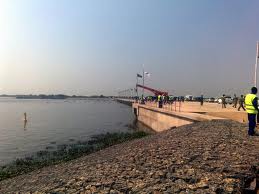 In October 2010 Nsanje Inland Port was ceremonially presented to the world. Zimbabwe’s Mugabe and Zambia’s then president Banda showed up to stand by their friend Mutharika. Fourteen month passed, the planned business hub serves local fishermen as fishing ground, the construction decays more and more and not even one vessel unloaded its freight. At least the almost two years lasting diplomatic differences seem to be overcome.
In October 2010 Nsanje Inland Port was ceremonially presented to the world. Zimbabwe’s Mugabe and Zambia’s then president Banda showed up to stand by their friend Mutharika. Fourteen month passed, the planned business hub serves local fishermen as fishing ground, the construction decays more and more and not even one vessel unloaded its freight. At least the almost two years lasting diplomatic differences seem to be overcome.
The Shire-Zambezi waterway would connect landlocked Malawi with the Indian Ocean. The Shire River flows into the Zambezi River that for its part flows into the Indian Ocean via Chinde Port in Mozambique. In total this route is about 238 km long.
Originally the Nsanje Port was regarded as Mutharika’s prestige project. With the new Shire-Zambezi waterway he intended to overcome yearly high import costs, improve the Malawian infrastructure and contribute his part to an improvement of the whole region’s economical scene. The new port was supposed to serve as path-breaking project. On the president’s list of achievements it would have added a project that could be an example to future developments. The contrary occurred. Instead of a prospering business hub the port can be found today in lousy conditions. The harbor basin which still served local fishermen as fishing ground after the opening in 2010 cannot even be used for fishing activities anymore. The water is green and dark and spreading grass turned the whole scenery rather into a bushy island than a business area. Furthermore recent vandalism has affected the constructions enormously. Steel objects have been dismantled and stolen.
The failed appearance of changes in the Nsanje district currently results in the disappointment of local villagers. According to malawitoday, a Boma resident said:
I had a great sense of hope and optimism when the project was launched. Coupled with nice roads that have changed the face of the district, Nsanje was full of smiles. Now, we are at a crossroads. We are still hopeful, but at the same time, we can also smell deep disappointment, especially with so little progress so far
Since Nsanje port was officially opened in October 2010, no freight has been arrived via the new waterway. Besides missing infrastructure and an economical crisis in Malawi, a diplomatic fiasco contributed its part to the absent logistical activity of the harbor. When president Bingu wa Mutharika opened Nsanje Inland Port 2010, a vessel loaded with fertilizer for adding lustre to the ceremony was on its way to Nsanje. But this freight never reached the harbor basin because the Mozambique government stopped it in Mozambique waters. The result was an opening ceremony on a sunny day ruled by an embarrassing fiasco for president Mutharika.
During an economic summit in South Africa in November 2010 Mozambique president Armando Guebuz said:
You do not send ships along the territorial waters of another country without having very clear norms which indicate exactly what procedures must be followed. We are open and we are going to work on the matter… In this whole case, economic viability cannot be imposed, not even as a joke. A study should be made with our agreement. After this, we shall see what position to take.
More than one year later a Malawian delegation went to Nampula in Mozambique to conduct Mozambique officials for debating about the future agreements in terms of Nsanje port.
Since that meeting has been hold successfully in the beginning of this year, the cooled relations between the two countries have been re-established. The Malawian government finally agreed on independent studies about the actual impact of economic activities on the rivers’ environment, biodiversity and finally on the two countries’ security.
Fortunato Albrinho, the head of international relations in the Mozambique Transport Ministry said:
At this meeting, the Malawian government recognised that using the Shire and Zambezi rivers for Malawian imports and exports involves the sovereignty of our country. It recognizes that before any steps can be taken, there must be a cautious treatment of the matter.
While the delegates and their Mozambique counterparts finally reached an agreement, it is still not decided when the proposed studies are going to be started.
What remains is the question why the Malawian government did not conduct the Mozambique government from the very beginning. Diplomatic differences could have been avoided and the project could have been put to practice more efficiently. Instead, the harbor was not used for longer than a year and economic advantages remained unused. The Malawian government could have spared itself a lot of trouble simply by playing with one’s cards on the table.
After a long wasted period of inactivity it remains to be seen whether the announced studies will be conducted and if their results can lead to the final use of the Shire-Zambezi waterway for the purpose of transport.




